What should be the substrate and pot for an orchid?
The structure of many tropical plants is unusual, therefore, to create comfortable conditions, they need to pay attention to such important details as the selection of containers. Orchids interesting for their structure. Many plant species have aerial roots that attach the epiphyte to neighbors to maintain stability. To provide nutrition to the orchid, the roots need moisture, light. Hence the increased requirements for soil and flower pot.
It is easy to destroy a beautiful orchid without knowing the requirements for the selection of soil, a pot for it. The rest of the flower is not so demanding. It can survive a short drought. But if there is little light, food and air, then the orchid will wither.
Content:
- The best varieties of orchids to grow
- What kind of soil to choose for a flower?
- Rules for choosing a container for an orchid
- Advantages and Disadvantages of Plastic Pots
- Ceramic containers, their features
- Glass pots for orchids
- What other containers are suitable for orchids?
- Epiphyte care tips
The best varieties of orchids to grow
There are many types of tropical plants that are unusual in their appearance, but differ in the requirements for growing conditions:
- Phalaenopsis - one of the most popular orchids, which has shoots with both small flowers and large ones. In its homeland, the flower grows on trees that it needs for support. The plant has both ordinary roots and aerial ones. On the peduncles there are several flowers with side petals and a central loop, or lip. And the Phalaenopsis orchid has so many colors that you can choose according to your taste: from black and blue to red, yellow and white.
- Cattleya has large lipped flowers with petals that have a waxy surface and a lip gathered in a corrugation.
- The Cymbidium orchid has ten to thirteen flowers of various colors on hanging peduncles. And they last up to eight weeks without fading.
- Lady's slipper, or Pafiopedilum, blooms annually. Of the orchids, this species is the most unpretentious. He does not need huge containers for growth, therefore, a flower is rarely transplanted.
- The tiger orchid, or Oncidium, is recognized by its unusual pattern of yellow or reddish-brown petals.
- Delicate Miltonia is compared to pansies for the shape of the petals. The orchid does not tolerate the drying out of the soil in the pot.
- Dendrobium Nobile with pink, purple, red, brown buds blooms for a long time, for two to four months with good care. The petals are four to ten centimeters in diameter. This is one of the varieties of orchids that endure unfavorable living conditions.
- The beauty of the Wanda Orchid lies in the bright blue color of the petals. By the roots, the plant absorbs as much moisture as the flower needs.
All types of orchids have almost the same requirements for soil and choice of capacity.
What kind of soil to choose for a flower?
Soil for orchids is purchased in specialized stores or prepared independently.But it is important to know that decorative culture needs such components as pine cones, fern root, sphagnum moss... In addition to humus, the soil is based on the bark of a tree.
If the land is taken from the garden, then it is cleaned of weeds, debris, and disinfected.
It is better that the needles of coniferous trees come across in the soil. The plant reacts well to the scales of pine cones, which are added to the substrate for the epiphyte. The soil component should be sphagnum moss. It retains moisture well, helps to absorb it, and saturates the soil mixture with nutrients.
The fern root is dried, crushed, like the rest of the substrate components. If they want to do without garden soil, then it is replaced with clay granules, coarse sand. All soil components are mixed before planting the orchid. It is advisable to disinfect them with boiling water and dry them.
Rules for choosing a container for an orchid
Orchid blooms profusely and for a long time, if the plant pot is selected correctly. The volume of the container is important for the plant. Indeed, in cramped conditions, the roots of a flower cannot develop, they deform and rot. In spacious containers, they begin to grow beyond measure, intertwining with each other. Then there won't be enough food for the orchid.
Roots need light as they take part in photosynthesis.
Therefore, a transparent pot is needed for epiphytes. At the bottom of the container there should be holes with a diameter of three to seven millimeters. They are useful for draining excess liquid. The height of the container is chosen the same as the diameter of the neck. Having measured the volume of orchid rhizomes, take a pot 2-3 centimeters larger.
For weak plants, the same volume is possible.
Adult plants with aerial roots need hanging planters. The material from which the orchid pot is made should be good for air permeability. Before choosing a container for a flower, you need to think about its pros and cons for the development of an orchid.
Advantages and Disadvantages of Plastic Pots
The advantages of plastic containers are obvious. Pots:
- transparent
- have many holes not only on the bottom, but also on the side walls
- available to light
- maintain temperature stability
- provide an opportunity to observe the growth of orchid roots
But plastic does not allow air to pass through well, so the flower does not have enough of it. With abundant watering, water accumulates at the walls of the container, leading to acidification of the soil. Plastic pots are suitable for growing epiphytes by making more holes in the walls. And as a frame for them, it is better to use glass containers.
Ceramic containers, their features
The ceramic containers are ideal for orchids as they are breathable. A strong flowerpot makes the plant resistant, which is important for the growth of the flower. The roots inside the container have enough nutrients. They don't dry out. To prevent the walls of the ceramic pot from heating up quickly, use containers of light colors.
Smooth-walled ceramic pots are chosen because rough surfaces injure orchid roots.
Roots often grow to them, so it is difficult to tear them off the walls during transplantation. The disadvantages of porous ceramics are that the soil in the pots dries out quickly. There is a need for frequent watering of the orchid.
There are variations of clay vases for decorative flowers, they are produced with holes on the side walls. Clay containers are in demand among those who grow orchids.
Glass pots for orchids
Glass pots are a good container for growing orchids. They transmit light well. The pots are decorative, because they can be decorated with a pattern, choose the tonality of the flowerpot, suitable for the room.
But there are also disadvantages of the material, it is bad for the vegetation of the orchid. In glass containers, you cannot make additional holes for air penetration and excess moisture drainage. Hence the decay of the roots in the container, because the soil in the pot dries out unevenly.And due to the lack of air and a large amount of moisture on the walls in the container, algae coexist with the orchid.
A flower in a glass container may die, so it is better to use it as a planter, which contains a plastic container with a plant.
But it is advised to use glass containers for growing orchids without soil. When placed inside, the plant will feel good. And the person remains to observe his condition through the glass walls. Phalaenopsis or Wanda can live in this way.
What other containers are suitable for orchids?
The use of baskets in growing orchids is justified. Plants placed on the crushed bark of trees are supplied with air and light. Baskets can be of different shapes, made of metal, plastic or wood. Preference is given to bamboo containers. The basket is placed on a support or suspended depending on the type of orchid.
It is as if a flower feels in natural conditions when it is placed on a block with or without soil. A block can be a piece of bark, a driftwood taken from an apple tree, a fern rhizome, a piece of styrofoam. Plant babies take root well on blocks. The orchid container plays an important role in the well-being of the plant. It will bloom profusely, if the pot is selected correctly, it is a support for the flower.
Epiphyte care tips
There are no particular difficulties in caring for orchids:
- Flowers need an air temperature of at least 18 degrees. But they do not tolerate heat at 30 degrees too well.
- Water the orchids as the soil dries. Enough once or twice a week.
- You can dip the container with the orchid in a container of warm water for a few minutes two to three times a week.
- During the flowering of orchids, they need to create increased humidity in the room.
- An ornamental plant should be fed once a month, reducing the amount of fertilizer in winter. Use special fertilizers for orchids.
- In many plant species, the peduncle is cut off after the petals wilt.
- For a dormant period, place a pot with an orchid in a cool room.
- The plant is transplanted when the capacity becomes small for it.
Growing orchids is easy. If the pot is correctly selected, the appropriate soil, then the plant will live on the windowsill for a long time, delighting with the beauty of its flowers. It is important for orchid lovers to know what conditions an ornamental plant needs to create. Plays an important role not only the temperature, humidity in the room, but also the soil, the container in which it will live orchid.
More information can be found in the video:



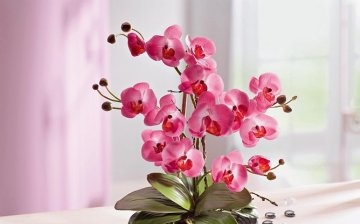
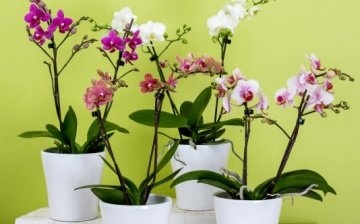
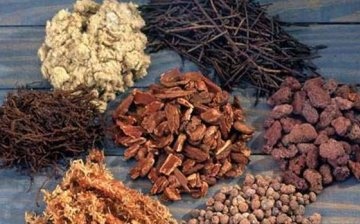
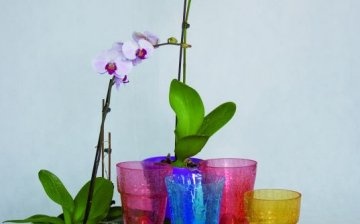
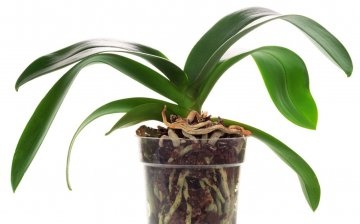
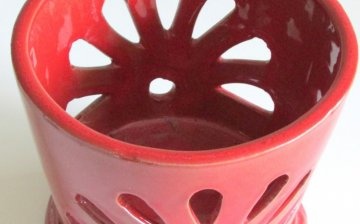
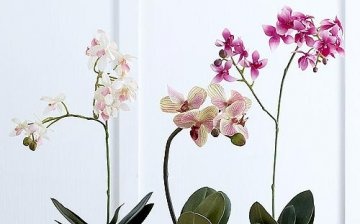
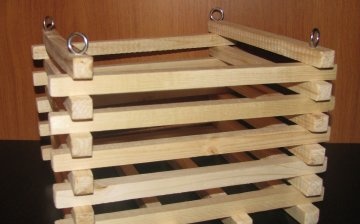
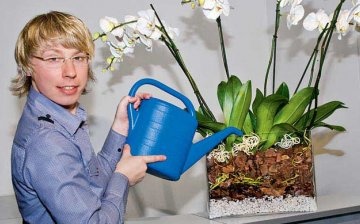









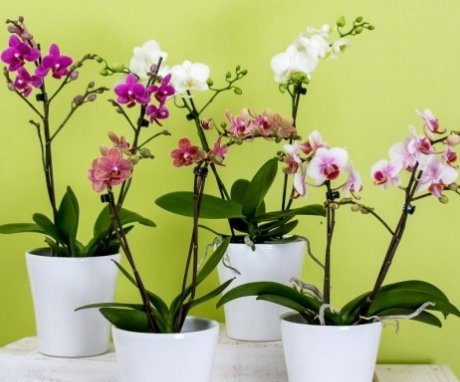
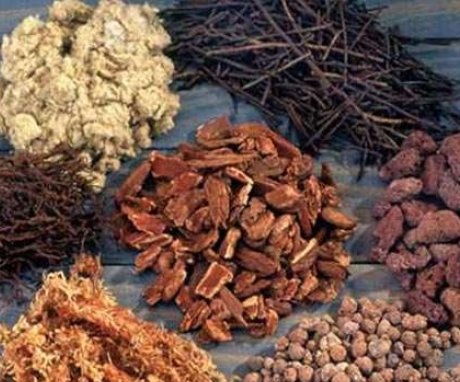

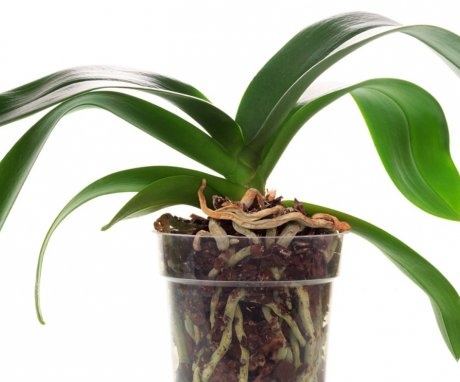
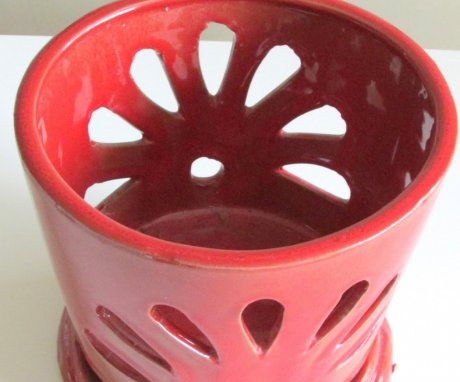
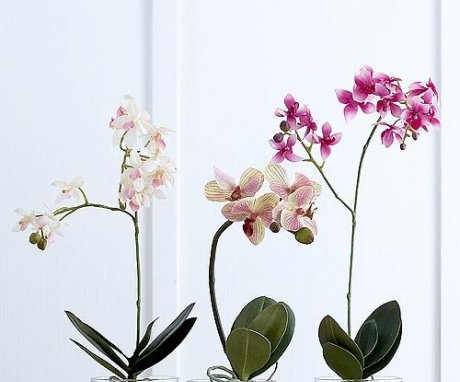

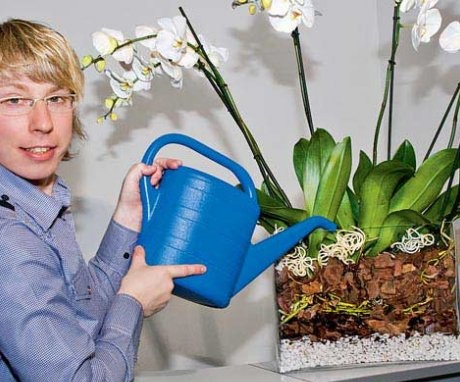
A month ago, they gave me an ochidea Cymbidium, I put it in a glass container, but it seems that is why its roots began to rot. Please tell me which pot it is better to transplant it into and how best to take care of it now in order to restore and strengthen the plant?
I had two orchids. Very expensive flowers. And unfortunately, no matter how hard I tried, both flowers died. Flowers are very difficult to groom. So I don't buy them anymore, I try to grow what is easier.
Cymbidium has a hard time enduring the heating season, I also did not manage to keep my flower. Phalaenopsis are more unpretentious, I plant them in transparent plastic pots and then place them in glass pots. I water it only by immersion and let it drain. Dendrobium Nobile from early spring to late autumn I keep on the balcony, only then it blooms, because it needs a temperature difference.
Our phalaenopsis orchid grows in a plastic pot with holes on the walls, which is filled with tree bark. We water the flower not often. It grows well and has bloomed several times.